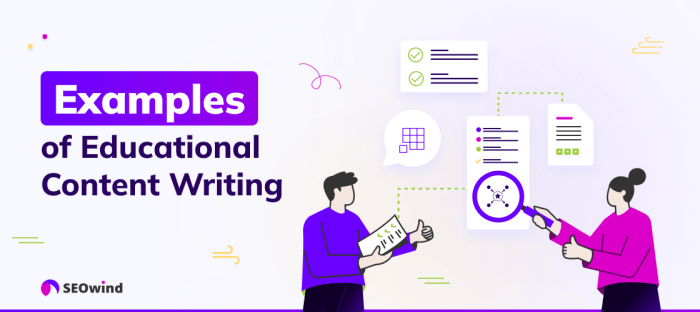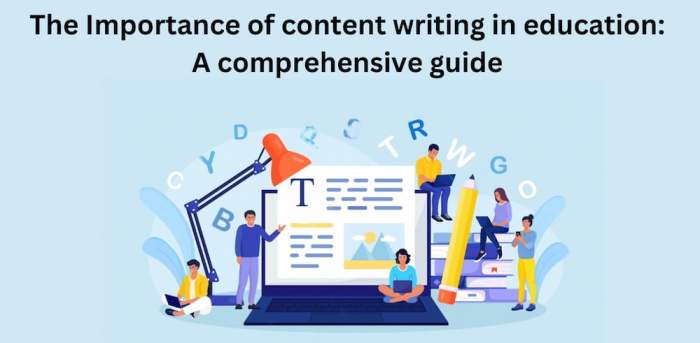Writing Educational Content sets the stage for creating dynamic and impactful learning resources that captivate audiences and enhance educational experiences. Dive into the world of educational content creation where creativity meets knowledge!
In this comprehensive guide, we will explore the essential aspects of crafting effective educational content that resonates with learners and elevates the quality of online education.
Importance of Writing Educational Content
Creating educational content is crucial for sharing knowledge in a way that is accessible, engaging, and informative. It allows for the dissemination of information to a wider audience, breaking down complex concepts into easy-to-understand formats.
Educational content plays a significant role in impacting learning outcomes by providing students with valuable resources that supplement traditional classroom instruction. For example, interactive videos, quizzes, and simulations can help reinforce key concepts and enhance retention.
In the realm of online courses and distance learning, educational content serves as the primary medium through which students engage with course material. Well-crafted content not only facilitates self-paced learning but also fosters a sense of community among learners, despite physical barriers.
Enhancing Student Engagement
- Educational content can incorporate multimedia elements such as videos, animations, and infographics to cater to diverse learning styles.
- Interactive quizzes and assessments can provide immediate feedback, allowing students to track their progress and identify areas for improvement.
- Discussion forums and virtual classrooms create opportunities for peer-to-peer interaction and collaborative learning.
Characteristics of Effective Educational Content

When it comes to creating educational content that truly resonates with students, there are key elements that can make a big difference. Engaging and informative materials are crucial for successful learning experiences.
Clear Structure and Organization
Having a clear structure and organization in educational materials is essential for helping students navigate the content effectively. When information is presented in a logical and organized manner, students can better understand the material and retain key concepts. This can be achieved through the use of headings, subheadings, bullet points, and other visual cues to guide students through the content.
Incorporating Visuals and Multimedia
Adding visuals and multimedia elements to educational content can greatly enhance the learning experience. Visual aids such as diagrams, charts, and infographics can help clarify complex concepts and make the material more engaging. Additionally, incorporating multimedia elements like videos, animations, and interactive simulations can cater to different learning styles and increase student engagement.
Strategies for Creating Engaging Educational Content

Creating engaging educational content is essential to keep learners interested and motivated. Here are some effective strategies to make your content more engaging:
Writing in a Conversational Tone
When writing educational content, it’s important to use a conversational tone to connect with learners on a personal level. Avoid using overly formal language and instead, write as if you’re having a conversation with the reader. This approach helps to make the content more relatable and easier to understand for students of all levels.
Using Real-World Examples
Incorporating real-world examples into your educational content is crucial for helping learners grasp complex concepts. By using relatable examples from everyday life, you can make abstract ideas more concrete and easier to comprehend. Real-world examples also show students how the concepts they’re learning apply in practical situations, making the content more engaging and relevant.
Incorporating Interactive Elements, Writing Educational Content
Adding interactive elements such as quizzes, polls, and discussions can greatly enhance the engagement level of your educational content. Interactive elements encourage active participation from learners, allowing them to test their knowledge, share their opinions, and engage with the material in a more dynamic way. By incorporating these elements, you can create a more interactive and engaging learning experience for your students.
Best Practices for Writing Educational Content
In the world of educational content, it is crucial to follow best practices to ensure that students receive the most effective and engaging learning experience. Let’s dive into some key strategies that can help elevate your educational content to the next level.
The Significance of Using Inclusive Language and Diverse Perspectives
When creating educational content, it is essential to use inclusive language that respects and represents the diversity of your audience. By incorporating diverse perspectives, you can make your content more relatable and engaging for students from various backgrounds. This not only fosters a sense of inclusivity but also enhances the overall learning experience by providing different viewpoints and experiences for students to consider.
Guidance on How to Align Educational Content with Learning Objectives
To ensure that your educational content is effective, it is crucial to align it with specific learning objectives. Before creating any content, clearly define the learning goals you want to achieve. Then, structure your content in a way that directly addresses these objectives. By keeping your content focused and aligned with learning outcomes, you can help students stay on track and make the most of their learning experience.
The Importance of Regular Updates and Revisions to Keep Content Relevant
In the fast-paced world of education, it is essential to regularly update and revise your educational content to keep it relevant and up-to-date. By staying current with developments in your field and incorporating new information, you can ensure that your content remains accurate and engaging for students. Regular updates also show students that you are committed to providing them with the most current and valuable learning materials, enhancing their overall educational experience.